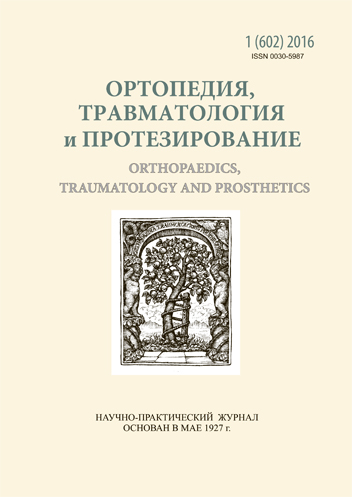Evaluation of the prevalence of tumor lesions of the proximal femur on the basis of spiral computed tomography
DOI:
https://doi.org/10.15674/0030-59872016141-49Keywords:
malignant bone tumors, proximal femur, spiral computed tomographyAbstract
The affection of the proximal femur with malignant tumors ranked first in the case of metastatic lesions and the second - among all sites of primary malignant tumors of the long bones. Anatomically, this area is quite sophisticated and high accuracy of topical diagnosis and evaluation of tumors prevalence is required. Spiral computed tomography (SCT) provides an accurate representation of tumors spread to bone and surrounding soft tissues. The problems of development patterns of extra-osteal component of tumor in upper third of the arm, soft tissue reconstruction, restoration of joint function and limb as a whole.
The goal: to investigate the features of lesions of bone and soft tissue structures in malignant tumors of the upper third of the thigh based SCT data.
The methods: the results of SCT studies of 55 patients with lesions of the upper third of the femur with malignant tumors were selected for analysis. SCT results were analyzed according to the method that was designed to assess the prevalence of tumor process in the proximal femur. The method is based on the study of tumor growth along the thigh, the direction and extent of the tumor extra-osteal component in the horizontal plane.
The results: a working classification of tumor dissemination in the proximal femur, depending on the extension of the tumor along a portion of the upper half of the thigh, the development direction and severity of tumor process in soft tissues is proposed.
Conclusion: the proposed working classification will help to determine the possibility of surgical treatment of patients with malignant tumors of the upper third of femur, as well as to clarify the indications for different types of organ-saving surgical treatment of with soft tissue reconstructive procedures for femur and hip to improve functional outcomes of patient treatment.References
- Vyrva OE. Modular custom made endoprosthesis in the treatment of malignant bone tumors of the limbs. Abstract of Dissertation for the scientific degree of Doctor of medical sciences, specialty 14.01.21 “Traumatology and Orthopaedics”. Kyiv, 2013, 46 p.
- Vyrva OE, Malyk RV, Golovina YaO, Burlaka VV. The role of spiral computer tomography angiography in the diagnosis and choice of treatment tactics of patients with malignant bone tumors. Modern Medical Technology. 2011;2:47–54.
- Vyrva OE, Levitska LM, Pechersky BV, Zmienko YuA. Spiral computer tomography angiography in the diagnosis and choice of treatment tactics of patients with malignant bone tumors. Roentgenology-practice. 2006;2:69–70.
- Sapunova LS, Frolova IG, Velichko SА, Bogoutdinova АV, Kotova ОV, Bober EE. Diagnostic imaging of bone sarcomas of the pelvic girdle. Syberia Oncology Journal – Sibirskii Onkologicheskii jurnal. 2015;3:26–30.
- Vyrva OE, Malyk RV, Golovina YaO, Burlaka VV. The role of spiral computer tomography angiography in the diagnosis and choice of treatment tactics of patients with malignant bone tumors. Modern Medical Technology. 2011;2:47–54.
- Haidukewych GJ. Metastatic disease around the hip. J Bone Joint Surg Br. 2012;94-B(11,Suppl.A):22–5. doi: 10.1302/0301-620X.94B10.30509.
- Anez-Bustillos L, Derikx LC, Verdonschot N, Calderon N, Zurakowski D, Snyder BD, Nazarian A, Tanck E. Finite element analysis and CT-based structural rigidity analysis to assess failure load in bones with simulated lytic defects. Bone. 2014;58:160–7. doi: 10.1016/j.bone.2013.10.009.
- DiCaprio MR, Friedlaender GE. Malignant Bone Tumors: Limb Sparing Versus Amputation. J Am. Acad. Orthop. Surg. 2003;11:25–37.
Downloads
How to Cite
Issue
Section
License
Copyright (c) 2016 Oleg Vyrva, Roman Malyk, Yanina Golovina

This work is licensed under a Creative Commons Attribution 4.0 International License.
The authors retain the right of authorship of their manuscript and pass the journal the right of the first publication of this article, which automatically become available from the date of publication under the terms of Creative Commons Attribution License, which allows others to freely distribute the published manuscript with mandatory linking to authors of the original research and the first publication of this one in this journal.
Authors have the right to enter into a separate supplemental agreement on the additional non-exclusive distribution of manuscript in the form in which it was published by the journal (i.e. to put work in electronic storage of an institution or publish as a part of the book) while maintaining the reference to the first publication of the manuscript in this journal.
The editorial policy of the journal allows authors and encourages manuscript accommodation online (i.e. in storage of an institution or on the personal websites) as before submission of the manuscript to the editorial office, and during its editorial processing because it contributes to productive scientific discussion and positively affects the efficiency and dynamics of the published manuscript citation (see The Effect of Open Access).














